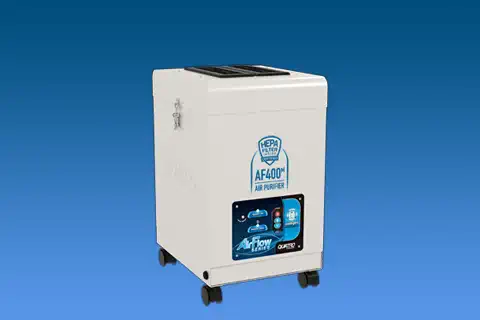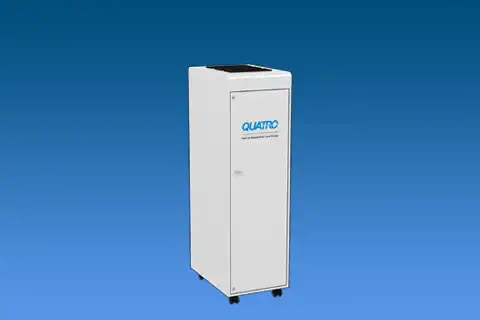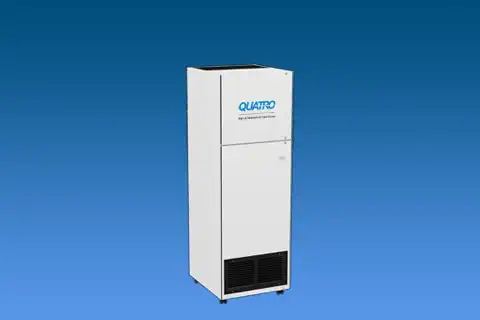Long-Term Care and Nursing Homes
Overview
 Charged with caring for our elderly, long-term care facilities have the responsibility of making sure seniors spend their remaining years as comfortably as possible. This includes providing an environment that is clean, healthy and free of toxic exposure.
Charged with caring for our elderly, long-term care facilities have the responsibility of making sure seniors spend their remaining years as comfortably as possible. This includes providing an environment that is clean, healthy and free of toxic exposure.
Most seniors in long-term care spend 90% or more of their time inside, so guaranteeing indoor air quality (IAQ) is up to standard is a must. The Environmental Protection Agency (EPA) estimates that indoor air is 2 to 5 times more polluted than outdoors. In some spaces, that figure could be much higher depending on the number of people living there, the location of the facility and the condition of the building.
While most nursing home administrators believe their IAQ to be good or excellent, nothing could be further from the truth. Studies show that 81% of long-term care facilities suffer from inadequate ventilation and circulation.
Poor air quality in nursing homes can have a disastrous effect on the health and wellbeing of residents. Failing to capture and filter out airborne contaminants can exacerbate and even cause chronic conditions as well as lead to deadly outbreaks of infectious disease, the likes of which we saw during the height of the Covid-19 pandemic.
The World Health Organization (WHO) attributes a number of noncommunicable diseases such as lung cancer, stroke, ischaemic heart disease and chronic obstructive pulmonary disease (COPD) solely to indoor air pollution. One 2017 study found that women living in highly polluted environments were almost twice as likely to develop dementia. And it has long been well understood that airborne particulates can aggravate existent pulmonary conditions such as asthma.
On the other hand, a residence with good to excellent air quality will see significant improvements in the health and quality of life of its seniors and staff. The Alzheimer’s Association has reported several studies proving significantly better health outcomes for seniors living in residences where airborne particulates were reduced. Older women in the U.S. saw 14% and 26% reduction in dementia risk and slower cognitive decline over a ten year period.
But clean air quality does more than improve the health outcomes and the quality of life of residents and staff, it can pay off financially as well. Along with the energy savings provided by installing efficient air filtration, long-term care facilities may experience increased revenue as more and more seniors are seeking nursing homes that prioritize IAQ.
Air Quality Challenges
Elderly people often have weakened immune systems and other age-rated health problems, putting them at particular risk of complications due to poor IAQ. That’s why it’s so important that nursing homes take special care to eliminate airborne toxins and pathogens.
The main contaminants affecting IAQ in long-term facilities include:
- Mold
- Volatile Organic Compounds (VOCs)
- Particulate Matter
- High Carbon Dioxide Levels
- Infectious Disease
- Ozone
Mold
Water spills, window condensation and plumbing leaks can all cause moisture buildup which leads to mold growth. Mold has spores that may contain mycotoxins, which could be poisonous. These spores can circulate throughout a building, contaminating indoor air.
Because it contains poisonous spores, mold is quite dangerous if inhaled. Symptoms associated with mold exposure include:
- Respiratory Issues
- Coughing
- Wheezing
- Allergic Rhinitis
- Headache
- Dizziness
- Poor concentration
- Nose Bleeds
- Rashes
The Occupational Safety and Health Association (OSHA) does not have standards for IAQ, but it does have regulations for toxins affecting IAQ - mold being one of them. To help protect residents from mold exposure, nursing homes can refer to the OSHA website for comprehensive guidelines on mold prevention and removal.
Volatile Organic Compounds (VOCs)
Volatile Organic Compounds (VOCs) are toxic gasses produced from a number of different sources in an indoor environment. They include formaldehyde, fire retardants and acetone as well as the off gassing of furniture, carpeting and office equipment such as printers and cleaning agents. The off gassing of Polyvinyl Chloride (PVC), a plastic used in a number of medical products, can be another source of VOCs. Levels of these gasses tend to be higher in newer buildings or freshly cleaned spaces.
Symptoms of VOC exposure include fatigue, irritability, brain fog and eye, nose and throat irritation. Exposure to high levels of VOCs is far more dangerous and can lead to:
- Skin Irritation
- Neurotoxic effects
- Liver toxicity
- Cancer
Particulate Matter
Particles are solid or liquid substances that include dust, dust mites, pollen, sulfates, aerosols, ash, fumes, metals and dirt. Light enough to suspend in the air, the largest of these particles can be seen with the naked eye, in a ray of sunlight. The smaller ones that are invisible pose the biggest inhalation hazard, as they can pass right through the nasal cavities and into the lungs.
Some particulate matter is brought in from outdoors but some originates from indoors such as from printing, copying and other equipment. Without a proper air purifier with HEPA filtration in place, these particles can circulate throughout an office and trigger allergy symptoms.
High Carbon Dioxide Levels
High carbon dioxide levels also negatively impact IAQ and puts seniors at risk for poor health outcomes. Indoor spaces with high CO2 have been shown to cause a number of adverse effects including drowsiness, fatigue, headaches, dizziness and respiratory problems.
According to the American Society of Heating, Refrigerating, Air-Conditioning Engineers (ASHRAE), CO2 concentrations should be lower than 1000 parts per million (ppm) to maintain good air quality. The American National Standards Institute (ANSI)/ American Society of Heating, Refrigerating and Air Conditioning Engineers (ASHRAE) have guidelines for ventilation system design for acceptable IAQ. Standards 62.1 and 62.2 outline minimum ventilation rates and other measures nursing homes can take to curtail the adverse health effects of poor air quality.
Infectious Disease
The COVID pandemic of 2020 taught us how vulnerable to infectious disease our nursing home population can be if appropriate measures are not taken. Capturing airborne pathogens to reduce infections and properly implementing isolation measures should be a priority for any long-term care facility.
A cough or sneeze can propel infectious pollutants as much as 200 feet and remain airborne long enough to reach ceiling ventilation units, risking the health of immunocompromised patients in particular. To contain airborne pollutants and prevent their spread, implementing negative and positive pressure rooms can be highly effective.
A negative pressure room uses a HEPA air purifier to create lower air pressure inside the room so harmful particles are trapped and kept from leaving. Negative pressure rooms are implemented to isolate people with infectious diseases and protect others outside the room from exposure.
Positive pressure uses higher pressure inside the room so air can escape but not circulate back in. Any germs or airborne particles will be filtered out and any harmful pollutants will be prevented from coming back in so the patient in the room remains protected. They are generally used for those patients who are particularly vulnerable to infectious disease such as people with compromised immune systems.
Ozone
An inorganic molecule with a distinct pungent smell, ozone is a form of oxygen that is emitted from various machines such as UV air cleaners. In nursing homes, the likely culprits of ozone emissions are medical devices.
Exposure has been known to lead to increased medication use, emergency room and doctor visits as well as hospital admissions. Linked to a number of adverse health effects mostly involving the lungs, ozone pollution can cause:
- Coughing and Sore Throat
- Difficult and Painful Breathing
- Inflammation and Damage to Airways
- Susceptibility to Infections
- Aggravation of Asthma, Emphysema and Chronic Bronchitis
- More Frequent Asthma Attacks
Solutions for Nursing Homes and Long-Term Care Facilities
To improve the health and wellness of their residents, nursing homes need to prioritize their IAQ. HEPA air purifiers along with the creation of negative and positive pressure rooms are an effective way to control hazardous air pollutants, unwanted odors and protect patients and staff from deadly outbreaks.

AF 400MNP
HEPA Air Purifier
Recirculation or negative pressure-ready. Up to 280 CFM nominal air flow.
Part Number#: AF400MNP
>> View Product Details

AF 1000MNP
HEPA Air Purifier
Recirculation or negative pressure-ready. Up to 500 CFM nominal air flow.
Part Number#: AF1000MNP
>> View Product Details

AF 2000MNP
HEPA Air Purifier
Recirculation or negative pressure-ready. Up to 1000 CFM nominal air flow.
Part Number#: AF2000MNP
>> View Product Details